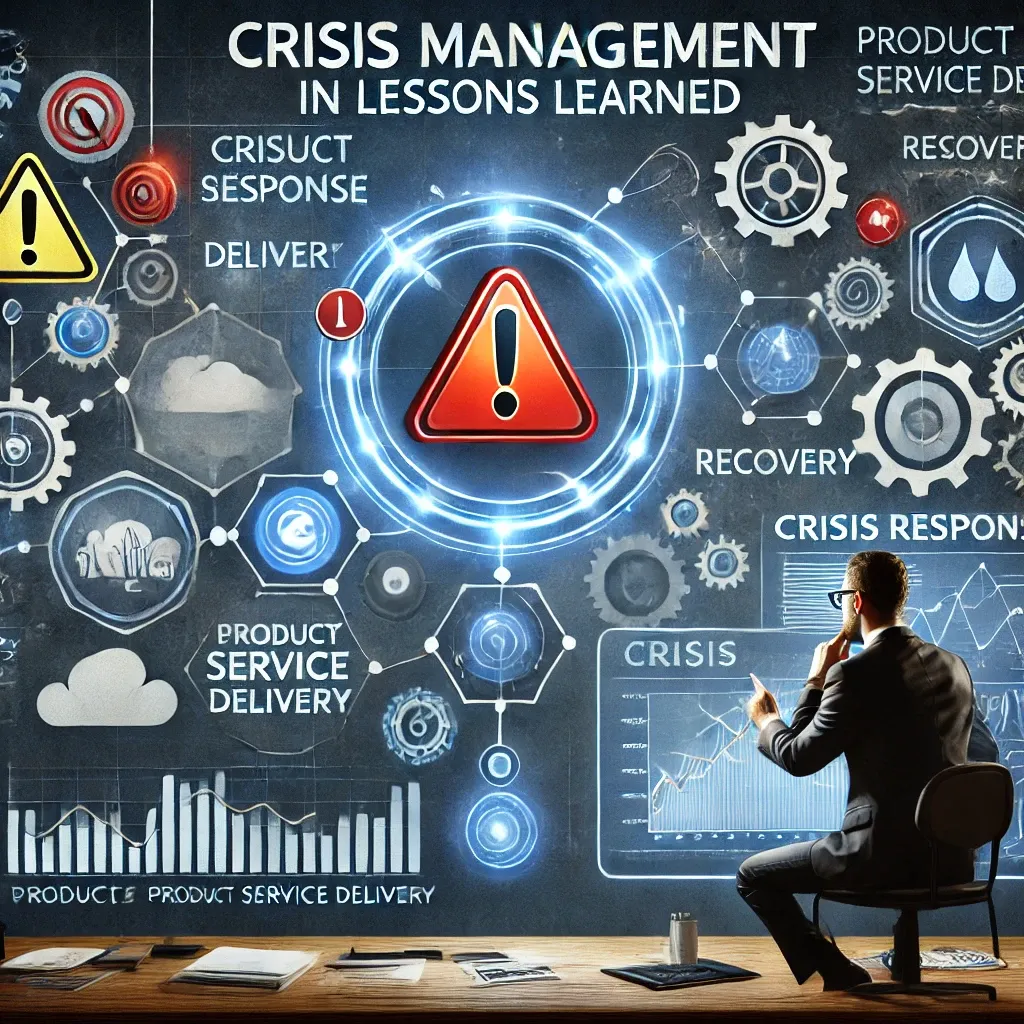Introduction
Product service management plays a pivotal role in ensuring that products not only meet customer expectations but also deliver ongoing value through effective service delivery. This discipline encompasses the planning, development, and management of both products and the services that support them, making it essential for project leaders to integrate these elements seamlessly. By aligning product offerings with customer needs and expectations, organizations can enhance customer satisfaction and loyalty, which are critical for long-term success.
However, the journey of product service delivery is not without its challenges. Crises can arise unexpectedly, threatening the integrity of the product and the satisfaction of the customer. Crisis management within this context refers to the strategies and actions taken to address and mitigate the impact of unforeseen events that disrupt service delivery. This includes everything from product recalls to service outages, and it requires a well-coordinated response to maintain trust and minimize damage.
The goal of this blog post is to delve into case studies of successful crisis management in product service delivery. By analyzing these real-world examples, we aim to extract valuable lessons that crisis managers and project leaders can apply to their own practices. Understanding how others have navigated crises can provide insights into effective strategies, enhance preparedness, and ultimately lead to more resilient product service management frameworks. Through this exploration, we will highlight the importance of proactive planning, clear communication, and the ability to adapt in the face of challenges, ensuring that organizations can continue to deliver exceptional value to their customers even in times of crisis.
Understanding Crisis Management in Product Services
Crisis management in product service delivery is a critical aspect of project management that ensures organizations can effectively navigate unexpected challenges. This section aims to provide a foundational understanding of crisis management principles specifically related to product services, focusing on defining crises, their impacts, and effective management strategies.
Defining a Crisis in Product Service Delivery
A crisis in product service delivery can be defined as any unexpected event or situation that disrupts the normal functioning of a product or service, potentially leading to significant negative consequences. This could include:
- Product Recalls: Issues arising from safety concerns or defects that necessitate the withdrawal of a product from the market.
- Service Interruptions: Situations where a service is temporarily unavailable due to technical failures or external factors.
- Reputation Damage: Events that can harm the brand’s reputation, such as negative media coverage or customer complaints.
Understanding what constitutes a crisis is essential for crisis managers and project leaders, as it allows them to identify potential threats and prepare accordingly [11][12].
Potential Impacts of a Crisis on Product Services and Project Outcomes
The impacts of a crisis on product services can be profound and multifaceted, affecting various aspects of an organization, including:
- Financial Losses: Crises can lead to direct financial losses due to product recalls, service interruptions, or legal liabilities. The costs associated with managing a crisis can also strain resources and budgets [10].
- Customer Trust and Loyalty: A crisis can erode customer trust and loyalty, leading to a decline in sales and long-term relationships. Customers may choose to switch to competitors if they perceive a lack of responsiveness or transparency during a crisis [2][10].
- Operational Disruptions: Crises can disrupt normal operations, leading to delays in product delivery, service provision, and project timelines. This can result in missed deadlines and increased pressure on project teams [14].
- Reputational Damage: The long-term effects of a crisis can include damage to the organization’s reputation, which may take years to rebuild. Negative perceptions can linger, affecting future business opportunities and partnerships [12][15].
Key Components of Effective Crisis Management Strategies
To effectively manage crises in product service delivery, organizations should implement comprehensive crisis management strategies that include the following key components:
- Crisis Communication Plan: Establishing a clear communication plan is vital for ensuring that all stakeholders are informed and updated throughout the crisis. This includes internal communication with team members and external communication with customers and the media [3][5].
- Crisis Management Team: Appointing a dedicated crisis management team is essential for coordinating responses and making informed decisions during a crisis. This team should include representatives from various departments, such as product management, customer service, and public relations [5][10].
- Risk Assessment and Preparedness: Conducting regular risk assessments to identify potential crises and developing preparedness plans can help organizations respond more effectively when a crisis occurs. This proactive approach minimizes the impact of crises on product services [6][11].
- Post-Crisis Evaluation: After a crisis has been managed, conducting a thorough evaluation of the response can provide valuable insights for future crisis management efforts. This includes analyzing what worked well, what could be improved, and how to better prepare for similar situations in the future [4][14].
By understanding the nature of crises in product service delivery, their potential impacts, and the components of effective crisis management strategies, crisis managers and project leaders can better navigate challenges and ensure the resilience of their organizations.
Case Study 1: A Technology Company’s Product Recall
Effective crisis management is crucial, especially when dealing with product recalls. This case study examines a notable incident involving a technology company that faced a significant product recall, analyzing the strategies employed and the lessons learned.
Incident Overview
The crisis began when the technology company discovered a defect in one of its flagship products, which posed safety risks to consumers. Reports surfaced about overheating issues that could potentially lead to fires, prompting the company to take immediate action. The decision to initiate a recall was driven by a commitment to consumer safety and brand integrity, as well as regulatory pressures that mandated swift action to mitigate risks associated with the defective product.
Crisis Management Strategy
The company implemented a comprehensive crisis management strategy that included several key components:
- Transparency and Communication: The company prioritized clear and open communication with stakeholders, including customers, employees, and regulatory bodies. They issued public statements acknowledging the issue and outlining the steps being taken to address it. This transparency helped to maintain trust and credibility during a challenging time [4].
- Crisis Management Team: A dedicated crisis management team was established, comprising members from various departments, including public relations, legal, and product development. This cross-functional team was responsible for coordinating the response and ensuring that all communications were consistent and aligned with the company’s key messages [15].
- Customer Support Initiatives: The company set up a robust customer support system to handle inquiries and concerns related to the recall. They provided clear instructions on how customers could return the product and receive refunds or replacements, which helped to alleviate customer frustration and confusion [11].
- Monitoring and Feedback: Throughout the recall process, the company utilized social media monitoring tools to gauge public sentiment and gather feedback. This allowed them to adjust their communication strategy in real-time and address any emerging concerns promptly [15].
Key Lessons Learned
The incident provided several valuable lessons that improved the company’s future product service delivery:
- Proactive Risk Management: The crisis underscored the importance of proactive risk management strategies. The company recognized the need to conduct thorough product testing and quality assurance processes to identify potential issues before they escalate into crises [13].
- Importance of Preparedness: The experience highlighted the necessity of having a well-defined crisis management plan in place. The company learned that regular training and simulations for crisis scenarios could enhance their readiness to respond effectively in the future [8].
- Stakeholder Engagement: Engaging with stakeholders throughout the crisis was crucial. The company learned that maintaining open lines of communication not only helped to manage the immediate crisis but also fostered long-term relationships with customers and partners [4][14].
- Continuous Improvement: Finally, the company adopted a culture of continuous improvement, using the insights gained from the crisis to refine their product service management processes. This included implementing feedback loops to ensure that lessons learned were integrated into future product development and service delivery strategies [13].
Case Study 2: A Retail Brand’s Supply Chain Disruption
Effective crisis management is crucial, especially when dealing with supply chain disruptions. This case study examines a retail brand that faced significant challenges due to a supply chain crisis, highlighting the strategies employed by project leaders to navigate the situation and the lessons learned for future applications.
Nature of the Supply Chain Disruption
The retail brand encountered a severe supply chain disruption triggered by a combination of natural disasters and political instability in key supplier regions. These unforeseen events led to delays in the delivery of essential goods, creating a ripple effect that impacted inventory levels and customer satisfaction. The crisis was characterized by:
- Increased Lead Times: The time taken to receive products from suppliers significantly increased, leading to stock shortages.
- Customer Backlash: Customers expressed frustration over delayed orders, which threatened the brand’s reputation and customer loyalty.
- Operational Challenges: The disruption strained the operational capabilities of the retail brand, forcing them to reassess their supply chain strategies.
Responses Taken by Project Leaders
In response to the crisis, project leaders implemented several strategic measures to mitigate the impact of the supply chain disruption:
- Diversification of Suppliers: Recognizing the risks associated with relying on a limited number of suppliers, the project leaders diversified their supplier base. This included identifying alternative suppliers in different geographical locations to reduce dependency on any single source [1].
- Strengthening Relationships: The team focused on maintaining strong relationships with key suppliers, ensuring open lines of communication. This proactive approach allowed for better collaboration and quicker responses to emerging issues [1].
- Contingency Planning: A comprehensive contingency plan was developed, which included strategies for rapid response to future disruptions. This plan outlined specific actions to be taken in the event of similar crises, ensuring that the team was prepared to act swiftly [1][2].
- Real-Time Tracking Tools: The implementation of shared, real-time tracking and visibility tools facilitated better coordination with suppliers. This technology enabled the project leaders to monitor supply chain status and make informed decisions quickly [1][2].
Outcomes and Lessons Learned
The crisis management strategies employed by the retail brand yielded several positive outcomes:
- Restored Customer Trust: By effectively communicating with customers and providing timely updates, the brand was able to restore trust and mitigate backlash. Customers appreciated the transparency and responsiveness of the brand during the crisis [1].
- Improved Supply Chain Resilience: The diversification of suppliers and the establishment of contingency plans enhanced the overall resilience of the supply chain. The brand emerged from the crisis with a more robust supply chain capable of handling future disruptions [1][2].
- Enhanced Crisis Management Framework: The experience underscored the importance of having a well-defined crisis management framework. The lessons learned from this disruption have been integrated into the brand’s ongoing crisis management strategies, ensuring that project leaders are better prepared for future challenges [1][2].
Common Themes in Successful Crisis Management
Effective crisis management is essential for maintaining operational integrity and safeguarding brand reputation. Analyzing various case studies reveals several common themes that contribute to successful crisis management. Here are the key points distilled from these analyses:
Recurring Strategies and Best Practices
- Proactive Planning: Successful organizations often engage in proactive crisis management planning. This involves identifying potential risks and developing comprehensive strategies to address them before they escalate. Companies that have implemented detailed crisis management plans tend to navigate challenges more effectively, minimizing disruption and financial loss [1][4].
- Cross-Functional Teams: Many case studies highlight the importance of establishing cross-functional crisis management teams. These teams bring together diverse expertise from various departments, ensuring a well-rounded approach to crisis resolution. This collaborative effort allows for quicker decision-making and more innovative solutions during a crisis [8][9].
- Learning from Past Experiences: Organizations that regularly review and learn from previous crises tend to improve their response strategies. By analyzing past failures and successes, they can refine their crisis management frameworks, making them more resilient to future challenges [6][7].
Importance of Communication and Stakeholder Engagement
- Transparent Communication: Effective communication is a cornerstone of successful crisis management. Companies that maintain transparency with stakeholders—such as customers, employees, and investors—during a crisis are more likely to retain trust and loyalty. Clear messaging helps to manage expectations and reduces misinformation [2][10].
- Engaging Stakeholders: Actively involving stakeholders in the crisis management process can lead to better outcomes. Engaging with customers and employees not only fosters a sense of community but also provides valuable insights that can inform decision-making. This engagement can take the form of regular updates, feedback sessions, and open forums for discussion [3][11].
Role of Preparedness and Training
- Regular Training Programs: Organizations that invest in regular crisis management training for their teams are better equipped to handle unexpected challenges. Training helps to instill a culture of preparedness, ensuring that employees know their roles and responsibilities during a crisis. This readiness can significantly reduce response times and improve overall effectiveness [4][8].
- Simulations and Drills: Conducting crisis simulations and drills is another effective strategy. These exercises allow teams to practice their response in a controlled environment, helping to identify weaknesses in their plans and improve coordination among team members. Such preparedness can make a substantial difference when a real crisis occurs [7][12].
Implementing Lessons Learned in Your Organization
Effective crisis management is crucial for maintaining operational integrity and customer trust. By analyzing successful case studies, crisis managers and project leaders can extract valuable lessons that can be implemented within their organizations. Here are actionable steps to apply these lessons effectively:
1. Develop a Tailored Crisis Management Plan
Creating a crisis management plan specifically for product service delivery involves several key components:
- Identify Potential Crises: Begin by assessing the types of crises that could impact your product services, such as supply chain disruptions, product recalls, or service outages. Understanding these risks allows for a more focused approach to crisis management [7].
- Establish Clear Objectives: Define what success looks like during a crisis. This could include minimizing downtime, maintaining customer satisfaction, or ensuring safety. Clear objectives guide the response efforts and help measure effectiveness [1].
- Create a Communication Strategy: Develop a plan for internal and external communication during a crisis. This should include timely updates to stakeholders, customers, and team members to ensure everyone is informed and aligned [12].
2. Encourage Regular Training and Simulations
Preparation is key to effective crisis management. Regular training and simulations can significantly enhance your team’s readiness:
- Conduct Crisis Simulations: Organize drills that mimic potential crisis scenarios relevant to your product services. This hands-on experience helps teams practice their response strategies and identify areas for improvement [8].
- Foster a Culture of Preparedness: Encourage a mindset where team members are always thinking about crisis readiness. This can be achieved through workshops, discussions, and sharing insights from past crises [6].
- Incorporate Lessons from Case Studies: Use real-life examples of successful crisis management to illustrate best practices during training sessions. This not only provides context but also inspires confidence in the team’s ability to handle crises [13].
3. Review and Update Crisis Management Strategies
Crisis management is not a one-time effort; it requires ongoing evaluation and adaptation:
- Conduct Post-Crisis Reviews: After a crisis, hold debriefing sessions to analyze what worked and what didn’t. This reflection is crucial for understanding the effectiveness of your response and identifying areas for improvement [4].
- Update the Crisis Management Plan: Based on insights gained from post-crisis reviews, revise your crisis management plan to incorporate new strategies, tools, and processes. This ensures that your organization remains agile and responsive to emerging threats [10].
- Stay Informed on Industry Changes: Regularly monitor industry trends and changes that could impact your product services. This proactive approach allows for timely updates to your crisis management strategies, ensuring they remain relevant and effective [2].
By implementing these actionable steps, crisis managers and project leaders can enhance their organization’s resilience in the face of potential crises, ultimately leading to more effective product service delivery and improved stakeholder trust.
Conclusion
In the realm of product service delivery, effective crisis management is not just a reactive measure; it is a proactive strategy that can significantly influence outcomes. The case studies analyzed throughout this blog have illustrated that organizations that implement robust crisis management plans are better equipped to navigate challenges, minimize disruptions, and maintain service quality. Here are the key takeaways:
- Impact on Product Service Delivery: Effective crisis management directly correlates with improved product service delivery. By anticipating potential crises and establishing clear protocols, organizations can mitigate risks and ensure continuity, ultimately enhancing customer satisfaction and trust. This proactive approach allows teams to respond swiftly and efficiently, reducing the negative impact on operations and reputation [2][5].
- Adopting Lessons Learned: The insights gained from successful case studies serve as valuable lessons for crisis managers and project leaders. By analyzing these examples, readers are encouraged to adopt best practices, such as forming dedicated crisis management teams, utilizing crisis management software, and developing clear communication strategies. These lessons can empower organizations to build resilience and adapt to unforeseen challenges effectively [4][11].
Find out more about Shaun Stoltz https://www.shaunstoltz.com/about/.
This post was written by an AI and reviewed/edited by a human.



